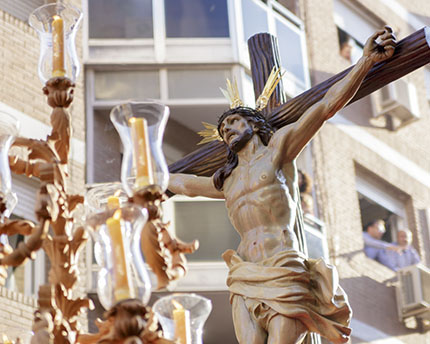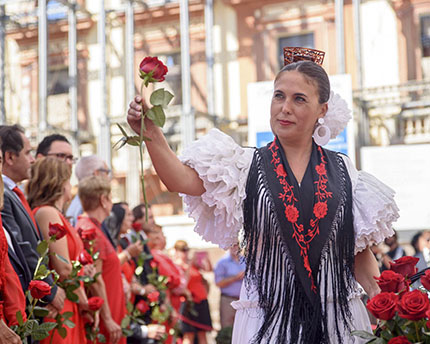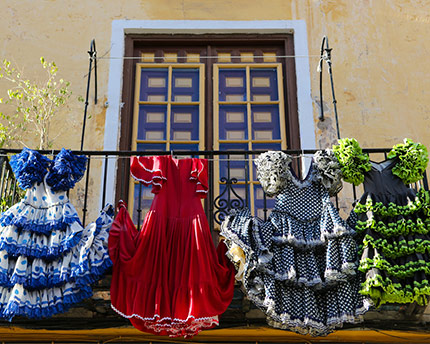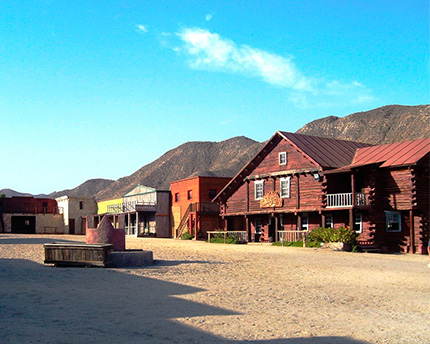Almeria may not be as widely known as Sevilla and Malaga for Holy Week celebrations but that doesn’t mean Holy Week isn’t fervently celebrated in Almeria. Declared a Holiday of National Interest in Andalusia in 2003, it includes all the key ingredients that have earned Semana Santa an international reputation: true religious zeal, the ardent saetas sung from balconies and the solemn tempo of the drums and bugles. Who hasn’t seen a striking image of the capirote-hooded figures in candlelit processions? Over the course of the week, nearly thirty brotherhoods take over the streets of the capital, the hooded penitents and believers march in solemn processions throughout the city centre.
The origins of Semana Santa in Almeria
The first Christian brotherhoods popped up in Andalusia, including Almeria, during the Middle Ages. The city of Almeria was one of the last cities under Muslim rule to be conquered by the Catholic Monarchs in 1489, almost three years before the final war of the Reconquista in Granada. The conversion of the city’s inhabitants to Catholicism prompted the creation of an association of converted believers, giving rise to the tradition of Holy Week processions in Almeria.
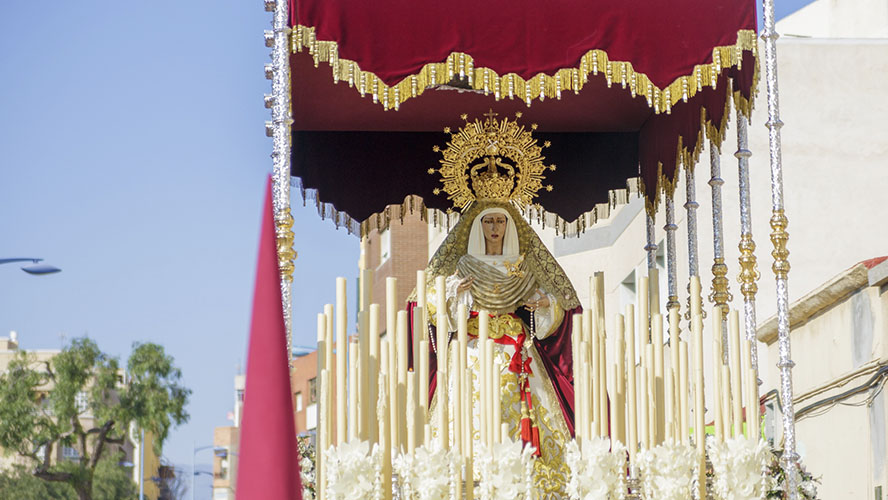
At the beginning of the 16th century, the first Via Crucis (The Way of the Cross) took place from the town hall. The procession reproduces the encounter of Jesus Christ with Mary on a street close to the Alcazaba. This street still exists today and it is called Calle del Encuentro. When the construction of the Cathedral was completed in 1562, processions began to leave from the cathedral instead.
Many brotherhoods disappeared in the 19th century as a result of the secular climate in Spain that reigned at that time. However, brotherhoods began to reappear at the beginning of the 20th century and except for the years of the Civil War, processions regained their place among Holy Week festivities.
Key moments of Holy Week in Almeria

Thousands of penitents take to the streets of Almeria during Holy Week. The first processions take place on Holy Saturday and Easter Sunday, a highly emotional experience for the faithful onlooker. One of these processions is Via Crucis de Silencio by the Santo Cristo del Perdón brotherhood on Holy Tuesday. The procession is carried out in complete silence, just like its famous cousin in Seville. It is a solemn moment that contrasts drastically with the characteristic liveliness of the festivities in southern Spain. The faithful are dressed in black cloaks and carry lanterns as they light the way for Christ.
Perhaps, the most iconic and special moment of the entire Almerian Holy Week after so many centuries, continues to be the Encounter. This procession takes place on Holy Thursday at Plaza Emilio Pérez, and not at the ancient Alcazaba as it used to. Three images are represented here by the Nazarene Brotherhood; they portray the encounter between Jesus Christ and Holy Mary of Sorrows.
Processions! Processions! Processions!
There are currently twenty-eight processions taking place during Holy Week. Twenty-three of which represent the Passion. These are scenes of events leading up to the Crucifixion of Christ. The other five represent Gloria, which are mostly images of the virgin. The brotherhoods have a very special place in the hearts of Almerians and visitors. Here are some of the most popular brotherhoods:
-
Hermandad Cristo del Amor
The Cristo del Amor de Almeria Brotherhood is one of the most distinguished of the city. The brotherhood was founded in 1944 by a group of bank and stock market employees. It marches on Holy Tuesday and also does a second procession with the Virgin.
-
Hermandad del Prendimiento
This brotherhood marches on Holy Wednesday and has three processions. Nuestro Padre Jesús en su Prendimiento (the Arrest of Our Father Jesus) represents Jesus when he was arrested. Nuestra Señora de la Merced is a traditional procession of the Virgin Mary. However, Cristo de Medinaceli de Almería is the most striking. The procession carries an impressive statue of Jesus, depicting him at the moment of his arrest: his hands are tied and he is wearing an impressive crown of thorns.
-
Hermandad de la Escucha
This is the only brotherhood to march in the early hours of Good Friday. The procession of Via Crucis begins at the Cathedral at 5 a.m. and marches by the sanctuary of la Virgen del Mar.
One of the most beloved processions by Almerians does not take place during Holy Week but on the Saturday before the last Sunday of August: the procession of the Virgen del Mar de Almería, the patron of the city of Almeria.
The sculpture was found in 1502 and it most likely came from a shipwreck or a ship attacked by pirates. The Hermandad de la Virgen del Mar was founded in 1520 and it continues to host the procession that marks the end of the Feria de Almería, in the summer.
Holy Week elsewhere in the province
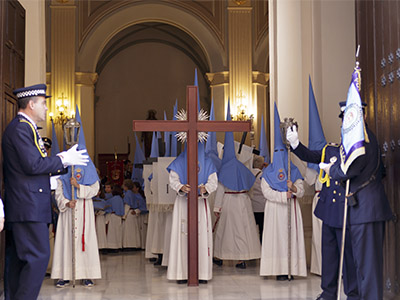
Holy Week is an important religious holiday throughout Andalusia. Every town and village has their very own traditions to mark this event. These include the festivities held in Cuevas de Almanzora, Vélez Rubio and Huércal-Overa. These festivities have been declared a Holiday of National Tourist Interest.
If you aren’t very interested in watching Holy Week processions during your holiday, head to Cabo de Gata. This magical, natural, beachside enclave is the perfect destination to soak up some rays. San José is another great destination. Located just 45 minutes from Almeria by car, it is the ideal launch pad to explore the wonderful beaches in the area, including Carboneras, Las Negras and Rodalquilar.
Almeria offers great attractions to make the most of your Easter holiday break. The pleasant weather, gorgeous beaches and the authentic fervour of Holy Week will give your holiday a unique flare. To learn more about this stunning destination, explore our guide to visiting Almeria.




































































